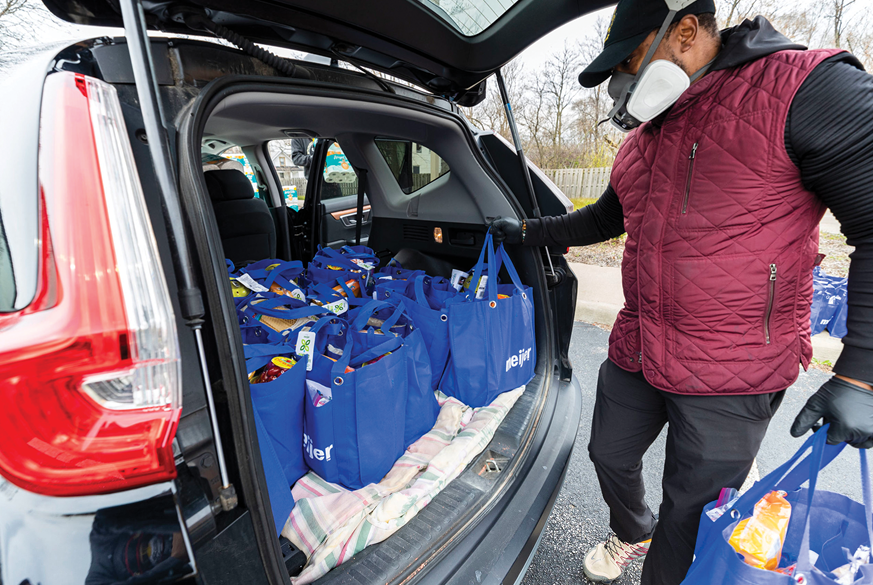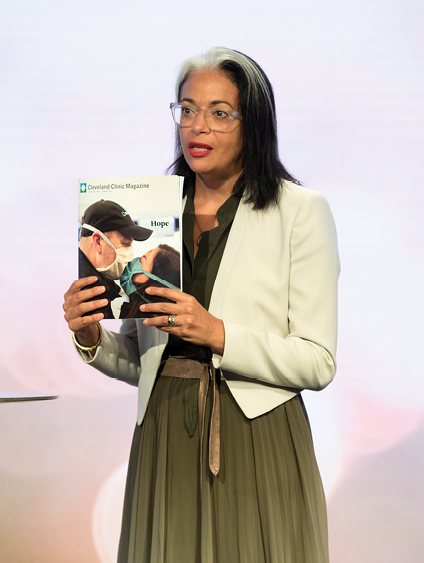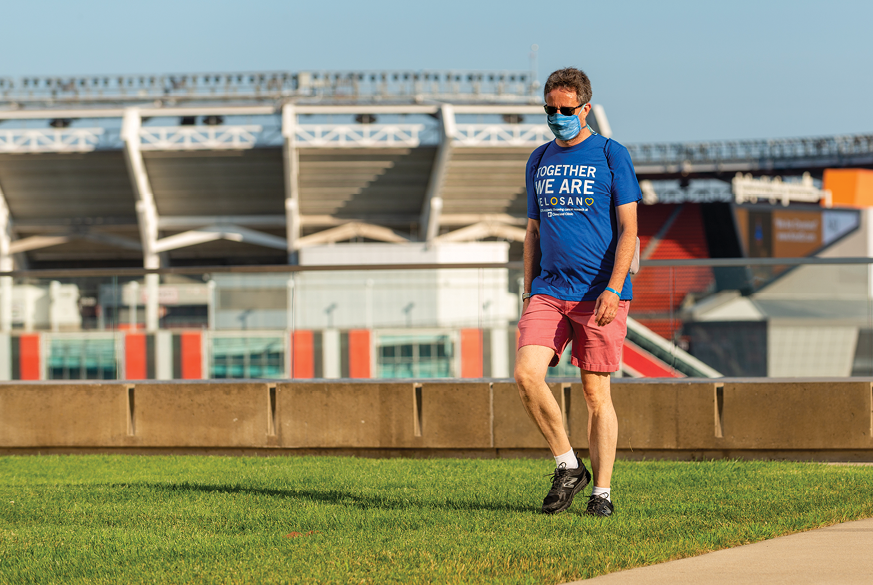- Home
- Media Kit
- Current Issue
- Past Issues
- Ad Specs-Submission
- Ad Print Settings
- Reprints (PDF)
- Photo Specifications (PDF)
- Contact Us
![]()
ONLINE
![]()
ONLINE

The Power
of Every One
Editors’ Note
Lara Kalafatis was named Chair of Philanthropy Institute, Cleveland Clinic, in January 2017. She is responsible for all philanthropic initiatives and capital campaigns for Cleveland Clinic and oversees the “Power of Every One” $2 billion campaign that launched in June 2014. Kalafatis is a member of the Executive Team of Cleveland Clinic. Previously, she served as Vice President for University Relations and Development at Case Western Reserve University. In 2007, she was inducted into Leadership Cleveland and, in 2006, Crain’s Business Cleveland recognized her as part of the 40 under 40 class for her leadership and community involvement. Kalafatis holds a B.A. in journalism and history from Indiana University Bloomington.
Institution Brief
Based in Cleveland, Ohio, Cleveland Clinic (clevelandclinic.org) is a nonprofit multispecialty academic medical center that integrates clinical and hospital care with research and education. It was founded in 1921 by four renowned physicians with a vision of providing outstanding patient care based upon the principles of cooperation, compassion and innovation. Cleveland Clinic has pioneered many medical breakthroughs, including coronary artery bypass surgery and the first face transplant in the United States. U.S. News & World Report consistently names Cleveland Clinic as one of the nation’s best hospitals in its annual “America’s Best Hospitals” survey. Cleveland Clinic has approximately 66,000 caregivers including more than 4,200 full-time salaried physicians and researchers and 16,000 nurses who represent 120 medical specialties and subspecialties.

In April 2020, as part of the COVID-19 Rapid Response
Campaign,
a team of volunteers from Cleveland Clinic’s
Langston Hughes Center
and employees from Meijer
worked together to distribute 4,000 poulds
of donated
supplies to residents in need in the city of Cleveland.
Will you provide an overview of your role at Cleveland Clinic and your key areas of focus?
I have been Chair of Cleveland Clinic’s Philanthropy Institute since 2017. I am responsible for strategy and management oversight of our philanthropic activities across the enterprise. Our vision is to raise funds to support Cleveland Clinic’s mission and strategic priorities. This includes our “Power of Every One” centennial campaign that has raised more than $2 billion to date and concludes at the end of 2021.
How did Cleveland Clinic’s Philanthropy Institute begin and how does the Institute operate within Cleveland Clinic?
The Philanthropy Institute is relatively new compared to the almost 100-year history of Cleveland Clinic. Our volunteer trustees have been integral to our success and our history. The idea to establish a philanthropic office for the enterprise was created in the 1990’s by trustee Joseph F. Callahan as an effort to compete with our peers. Cleveland Clinic CEO Floyd D. Loop, M.D., agreed to establish an “Office of Development,” hiring the first staff member, William Grimberg, to launch the five-year public campaign “Securing the 21st Century.” This inaugural campaign launched in 1997 with a goal of raising $225 million. In 2001, the campaign concluded early after raising $256 million and supporting the construction of the Taussig Cancer Center, Cole Eye Institute and Lerner Research Institute buildings.
The next campaign, “Today’s Innovations, Tomorrow’s Healthcare,” led by trustee Bob Rich, ran from 2002-2010 and raised $1.4 billion, surpassing the campaign’s original goal of $1.25 billion. Hallmarks of the campaign include the additions of the Miller Pavilion and Glickman Tower.
In 2012, under the leadership of CEO Delos (Toby) Cosgrove, the Institutional Relations and Development Office became known as the Philanthropy Institute.
Today, the “Power of Every One” campaign is guided by trustee co-chairs Larry Pollock and Stewart Kohl. Their leadership, numerous volunteer leaders and our team of more than 100 dedicated caregivers across the enterprise in Cleveland, Florida, Las Vegas and London guide our current philanthropic success.

Lara Kalafatis addresses the virtual audience at the
Cleveland Clinic Experience last July. The annual donor
event, which features updates from enterprise leaders
and the latest in Cleveland Clinic research, was held
as a live virtual program for
the first time this year.
What do you see as the key components to effective fundraising in the age of
COVID-19?
For Cleveland Clinic, the keys to effective fundraising in the midst of the pandemic have been flexibility, teamwork and communication. In March 2020, it became clear that we would need to pivot our “normal” operations to respond to both the needs of Cleveland Clinic and the interests and needs of our communities. We established a COVID-19 Rapid Response fund which has raised more than $22 million to date. We worked with the community to gather PPE donations, hosted drop-off stations for much needed supplies, worked with the corporate community with in-kind support and aligned with Supply Chain and Innovations on a “make, donate, manufacture” work stream that continues to work together today.
Another important element of our efforts is communication. We took much consideration to ensure our donors and community received COVID-19 insights from our physicians, scientists and clinical leaders by utilizing many tools and methods of communication.
How critical has it been to provide timely and accurate information to Cleveland Clinic’s donors while also orchestrating care and response to the pandemic?
When COVID-19 shut down the country in March, we found ourselves in a unique position as a top healthcare organization during a public health crisis. Our donors had many questions and were relying on us as a trusted source of information. We worked closely with our leaders, physicians, researchers and our communications teams to deliver information rapidly and accurately to donors of all gift sizes. We increased our email communications from monthly to weekly. We began a series of video interviews with our experts on COVID-19 specific topics. We offered webinars, phone calls, podcasts, and in July, hosted an all-day virtual event – Cleveland Clinic Experience – to engage, inform and educate our donors.
We also created a special edition of our Cleveland Clinic magazine to be entirely focused on COVID-19 with compelling stories and vivid imagery to capture this unique and impactful crisis.
Our donor community has expressed to us how much this timely and trusted information has informed them and helped them as they’ve made decisions on their own families’ safety and well-being.

Longtime VeloSano volunteer Tom Repko was one of
2,900 participants who took part in Virtual VeloSano,
walking more than 26 miles in downtown Cleveland
last summer to raise money for cancer research.
Cleveland Clinic has a long and storied past. How valuable has it been to have such deep experience and history in helping shape the institution’s response during this unprecedented time?
A large part of our history that continues to guide our principles today is our culture. For the past 100 years, Cleveland Clinic has held true to a commitment to work as a team of teams, guided by our leadership. From the first days of the pandemic, our leadership provided clear direction and communication which helped guide the actions of the Philanthropy Institute during this unprecedented time.
The strength of our organization was put to the test in 1929 when a devastating fire almost destroyed Cleveland Clinic while it was still in its infancy. The community responded with philanthropic support to ensure Cleveland Clinic would remain a pillar in our community.
Just as our leaders did more than 90 years ago, our leaders today remain committed to innovation, working as a team, and caring for the community.
Has the experience of the pandemic impacted the way Cleveland Clinic will
fund-raise in the future?
Yes – like many organizations, the COVID-19 pandemic has changed the way we fundraise and will continue to influence how we communicate with our donors and host events in the future. Many of the changes brought on by the pandemic happened quickly, such as moving from in-person meetings with donors to engaging both virtually and over the phone.
Before COVID-19, plans were already underway to add virtual components to our in-person fundraising events, but the pandemic pushed us to implement them quickly and robustly. By going virtual, major fundraising initiatives, such as our annual VeloSano Bike to Cure for cancer research were able to reach a global audience and acquire fundraising participants from well beyond Northeast Ohio.
While our means of communicating may have changed, what has not changed is the relationship building with our donors and our communities. Through these challenging times, we have continued to engage the interests of our donors, patients and greater community with the mission and vision of Cleveland Clinic.
How special is it for you to work at an institution that has shown such leadership and resilience during this challenging and unprecedented time?
Our efforts have been a reflection of our physician-led leadership and our model of care, which from the beginning set the tone for how we reacted. Our CEO made it clear that Cleveland Clinic was committed to caring for its employees. In a time when other healthcare organizations were eliminating jobs and cutting pay and benefits, we did not. This commitment translated into an even stronger pride within our organization. Our caregivers wanted to know, “what can I do to help the organization that has my best interests at heart?” As a result, our Philanthropy Institute worked with HR and the Office of Caregiver Experience to create ways for our own caregivers to give back to our communities and to each other during these unprecedented times.
How strong we will come out of this and how strong we will be going forward in the next 100 years will be determined by our continued compassion, caring and collaboration as one team worldwide.![]()